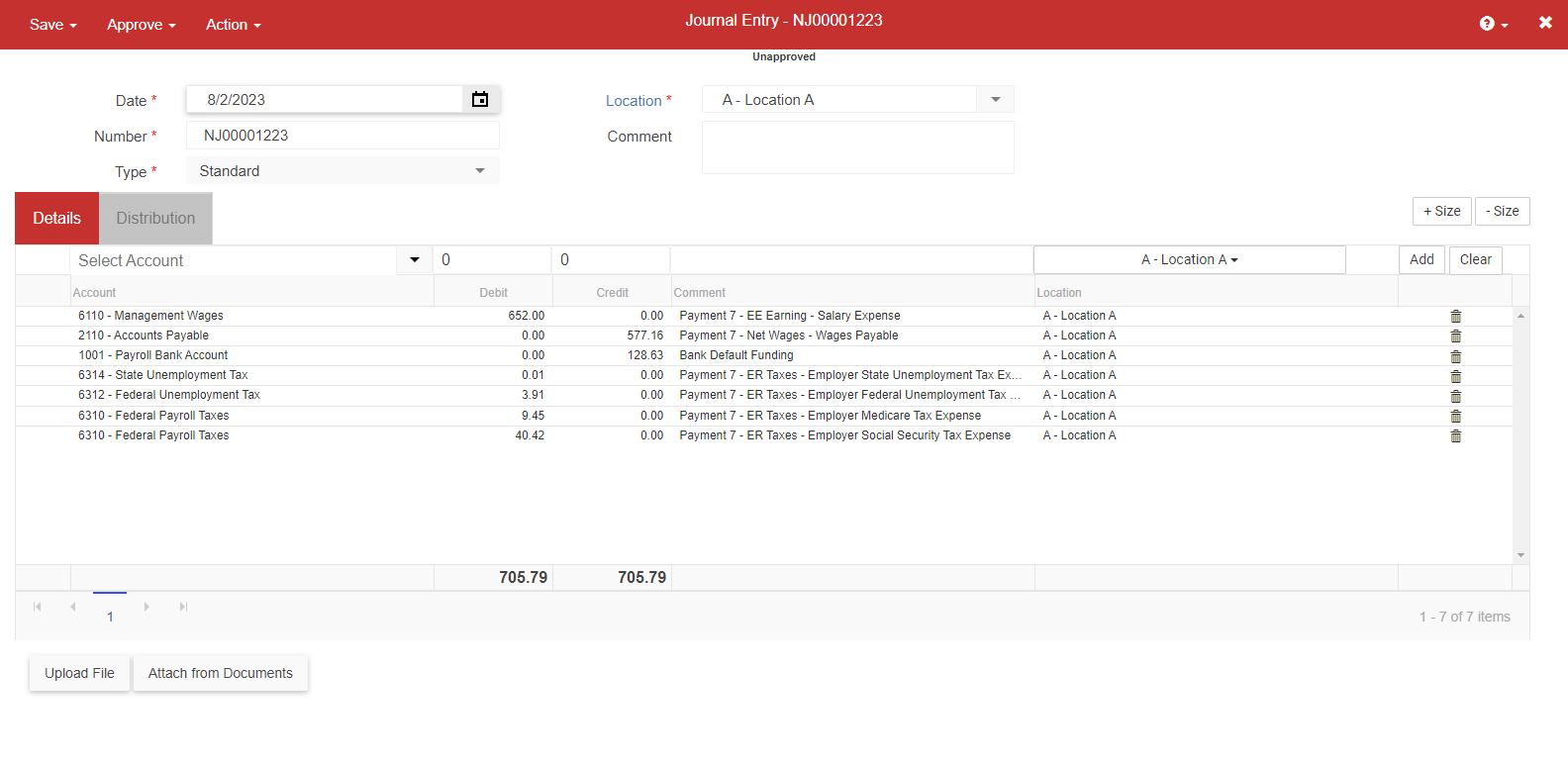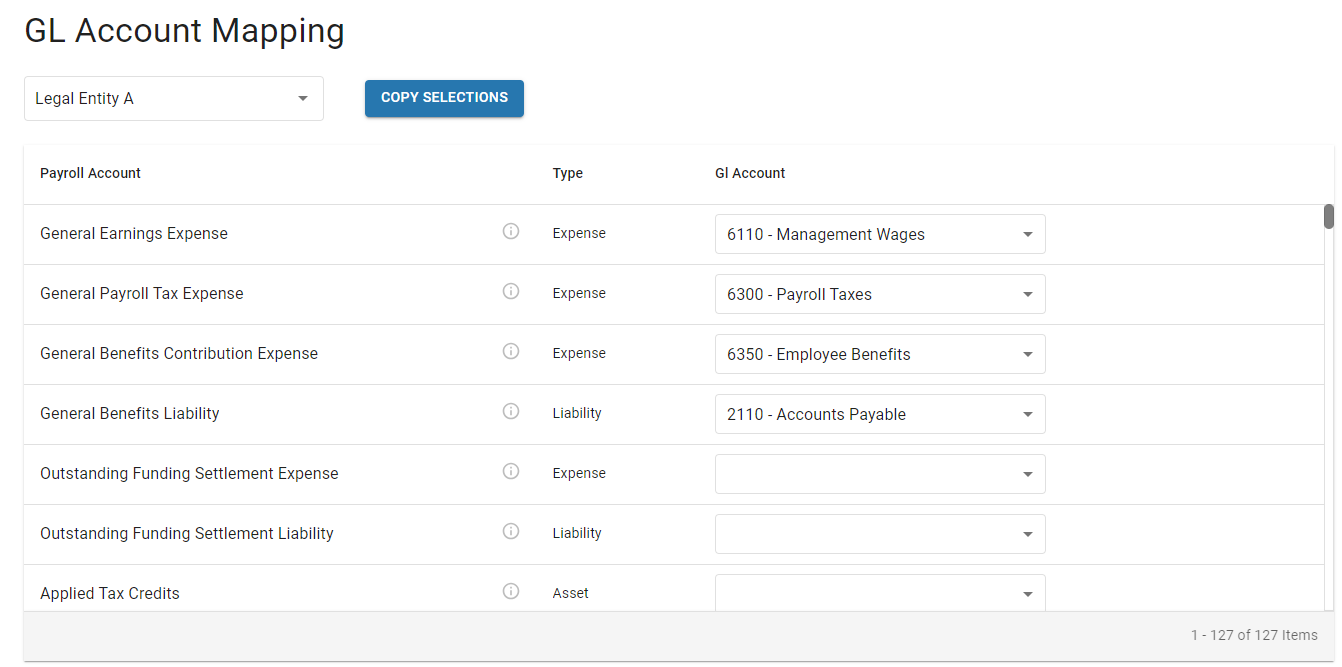Journal Entries Associated With Payroll
There are two types of journal entries in R365 Accounting associated with Workforce Payroll pay runs; funding journal entries and payroll journal entries.
When tips are paid by check, the Payroll Journal Entry debits and credits Tips Payable to reflect that the payment has been created but not yet cleared.
Once the check clears, the Funding Journal Entry debits Tips Payable and credits the Bank Account to complete the transaction.
For direct deposit payments, Tips Payable is debited and the Bank Account is credited in a single entry. No additional step is needed.
Funding Journal Entries
Funding journal entries are standard journal entries that record the funding for direct deposit payments and paper paychecks.
Funding journal entries include the following details:
Detail | Notes |
|---|---|
JE Date | Pay date of the pay run |
Type | Standard |
Credits | Default Payroll Check Account - Credited with employee payment amounts
|
Debits | Wages Payable account - Debited with total employee payments for wages Tips Payable account - Debited with total employee payments for tips
|
.png)
Payroll Journal Entries
Payroll journal entries contain estimated amounts from the DSS, actual amounts from the approved pay run, and the GL distribution difference. Learn more about estimated and actual payroll journal entries here. Payroll journal entries are created based on the selected payroll company and payroll clearing settings.
Payroll journal entries include the following details:
Detail | Notes |
|---|---|
JE Date | Pay period end date of the pay run |
Type | Payroll |
Payroll Start Date | Start date of pay run’s pay period |
Payroll End Date | End date of pay run’s pay period |
Debits | All Labor Expenses
|
Credits | Benefits Expenses Tax Expenses Withheld Employee Contributions Employee Net Pay
|

One-Time Payment Journal Entries
Payroll journal entries are not created for one-time payments, as there are no corresponding DSS-estimated payroll journal entries to clear. Instead, a standard journal entry is created with the payroll journal entry details.
Tax and Benefit Expenses for Employees Working Across Locations
When an employee works at multiple locations, the employer expense for taxes and benefits will be associated with the work location of the employee’s earnings, not necessarily the employee’s primary work location. Employer expenses are proportionally assigned based on the employee’s earnings at each location.
$0 Payments
When a payment in an approved pay run has $0 in earnings, $0 in taxes, and $0 in deductions, it is not included in payroll or funding journal entries.
Journal Entries & Paycheck Runs
The journal entries associated with a pay run are linked on the associated paycheck runs. Linked journal entries can be viewed and created by clicking on 'Journal Entries' in the header of the paycheck run.

Linked journal entries are displayed as their journal entry number. Clicking on the journal entry number will open the associated journal entry in a new tab.

Creating Funding and Payroll Journal Entries
Depending on system settings, journal entries associated with a pay run will either be created automatically when paycheck runs are created or must be manually created.
If the 'Enable Automatic Journal Entries' setting on the Miscellaneous tab of System Preferences is enabled, payroll and funding journal entries will be automatically created when paycheck runs are created.
If a paycheck run does not already have linked journal entries, they can be created manually on the associated Paycheck Run Details sidesheet.
.png)
Voiding Paychecks
When a paycheck within a pay run is voided, a reversal journal entry is automatically created. Since voiding the paycheck does not void the employee’s payment, the payroll journal entry is not updated.
.png)
Deleting Paycheck Runs
When a paycheck run is deleted, the linked funding and payroll journal entries are automatically deleted if they are unapproved. If the linked journal entries have been approved, they must be manually deleted in R365 Accounting.
Setup
Automatic Journal Entries
The 'Enable Automatic Journal Entries' setting on the Miscellaneous tab of System Preferences determines if payroll journal entries and funding journal entries are automatically created when each paycheck run is created. If this setting is not enabled, payroll journal entries and funding journal entries can be manually created after creating a paycheck run.
Payroll Journal Entries - Consolidate Bank Account Lines
By default, the bank account entry on payroll journal entries is consolidated to a single entry for all of the employee payments and tax disbursements associated with the pay run. The consolidated entry is frequently simpler to manage when performing bank reconciliations.
For more detail on payroll journal entries, the option to consolidate the bank account lines can be turned off. When disabled, each employee payment and tax disbursement will be listed as a separate entry. Each entry will note the employee’s name and payment number in the comments column.
The option to consolidate bank account lines is found on the Miscellaneous tab of System Preferences.

GL Mapping
The GL accounts assigned on the GL Account Mapping page will determine which GL accounts are used for journal entries.

Using the Job GL Account for Payroll Journal Entries
When the 'Use Job GL Account for Payroll Journal Entry' setting is enabled on the Miscellaneous tab of System Preferences, the GL account mapping for 'Salary Expense', 'Hourly Expense', and 'Hourly Overtime Expense' will not be used. Instead, journal entries will look to the job record associated with these earnings to determine the GL account.
Default Payroll Check Account
The ‘Default Payroll Check Account’ mapping on the legal entity record is the bank account used on funding journal entries.
GL Accounts assigned as default accounts cannot be deleted.
.png)